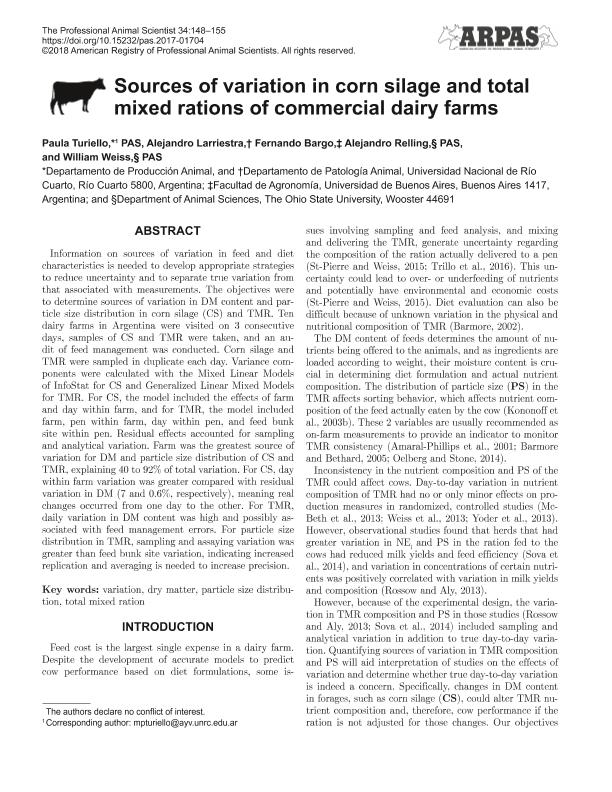Mostrar el registro sencillo del ítem
dc.contributor.author
Turiello, María Paula

dc.contributor.author
Larriestra, Alejandro Jose

dc.contributor.author
Bargo, Fernando
dc.contributor.author
Relling, Alejandro Enrique

dc.contributor.author
Weiss, William
dc.date.available
2019-09-02T19:04:54Z
dc.date.issued
2018-04
dc.identifier.citation
Turiello, María Paula; Larriestra, Alejandro Jose; Bargo, Fernando; Relling, Alejandro Enrique; Weiss, William; Sources of variation in corn silage and total mixed rations of commercial dairy farms; Elsevier Inc; Professional Animal Scientist; 34; 2; 4-2018; 148-155
dc.identifier.issn
1525-318X
dc.identifier.uri
http://hdl.handle.net/11336/82749
dc.description.abstract
Information on sources of variation in feed and diet characteristics is needed to develop appropriate strategies to reduce uncertainty and to separate true variation from that associated with measurements. The objectives were to determine sources of variation in DM content and particle size distribution in corn silage (CS) and TMR. Ten dairy farms in Argentina were visited on 3 consecutive days, samples of CS and TMR were taken, and an audit of feed management was conducted. Corn silage and TMR were sampled in duplicate each day. Variance components were calculated with the Mixed Linear Models of InfoStat for CS and Generalized Linear Mixed Models for TMR. For CS, the model included the effects of farm and day within farm, and for TMR, the model included farm, pen within farm, day within pen, and feed bunk site within pen. Residual effects accounted for sampling and analytical variation. Farm was the greatest source of variation for DM and particle size distribution of CS and TMR, explaining 40 to 92% of total variation. For CS, day within farm variation was greater compared with residual variation in DM (7 and 0.6%, respectively), meaning real changes occurred from one day to the other. For TMR, daily variation in DM content was high and possibly associated with feed management errors. For particle size distribution in TMR, sampling and assaying variation was greater than feed bunk site variation, indicating increased replication and averaging is needed to increase precision.
dc.format
application/pdf
dc.language.iso
eng
dc.publisher
Elsevier Inc

dc.rights
info:eu-repo/semantics/openAccess
dc.rights.uri
https://creativecommons.org/licenses/by-nc-sa/2.5/ar/
dc.subject
Dry Matter
dc.subject
Particle Size Distribution
dc.subject
Total Mixed Ration
dc.subject
Variation
dc.subject.classification
Producción Animal y Lechería

dc.subject.classification
Producción Animal y Lechería

dc.subject.classification
CIENCIAS AGRÍCOLAS

dc.title
Sources of variation in corn silage and total mixed rations of commercial dairy farms
dc.type
info:eu-repo/semantics/article
dc.type
info:ar-repo/semantics/artículo
dc.type
info:eu-repo/semantics/publishedVersion
dc.date.updated
2019-08-08T19:32:10Z
dc.journal.volume
34
dc.journal.number
2
dc.journal.pagination
148-155
dc.journal.pais
Estados Unidos

dc.journal.ciudad
Nueva York
dc.description.fil
Fil: Turiello, María Paula. Consejo Nacional de Investigaciones Científicas y Técnicas; Argentina. Universidad Nacional de Río Cuarto. Facultad de Agronomía y Veterinaria. Departamento de Producción Animal; Argentina
dc.description.fil
Fil: Larriestra, Alejandro Jose. Universidad Nacional de Río Cuarto. Facultad de Agronomía y Veterinaria. Departamento de Patología Animal; Argentina
dc.description.fil
Fil: Bargo, Fernando. Universidad de Buenos Aires. Facultad de Agronomía; Argentina
dc.description.fil
Fil: Relling, Alejandro Enrique. Consejo Nacional de Investigaciones Científicas y Técnicas. Centro Científico Tecnológico CONICET- La Plata. Instituto de Genética Veterinaria "Ing. Fernando Noel Dulout". Universidad Nacional de La Plata. Facultad de Ciencias Veterinarias. Instituto de Genética Veterinaria; Argentina. Ohio State University; Estados Unidos
dc.description.fil
Fil: Weiss, William. Ohio State University; Estados Unidos
dc.journal.title
Professional Animal Scientist
dc.relation.alternativeid
info:eu-repo/semantics/altIdentifier/doi/https://doi.org/10.15232/pas.2017-01704
dc.relation.alternativeid
info:eu-repo/semantics/altIdentifier/url/https://www.sciencedirect.com/science/article/pii/S1080744618300275
Archivos asociados
